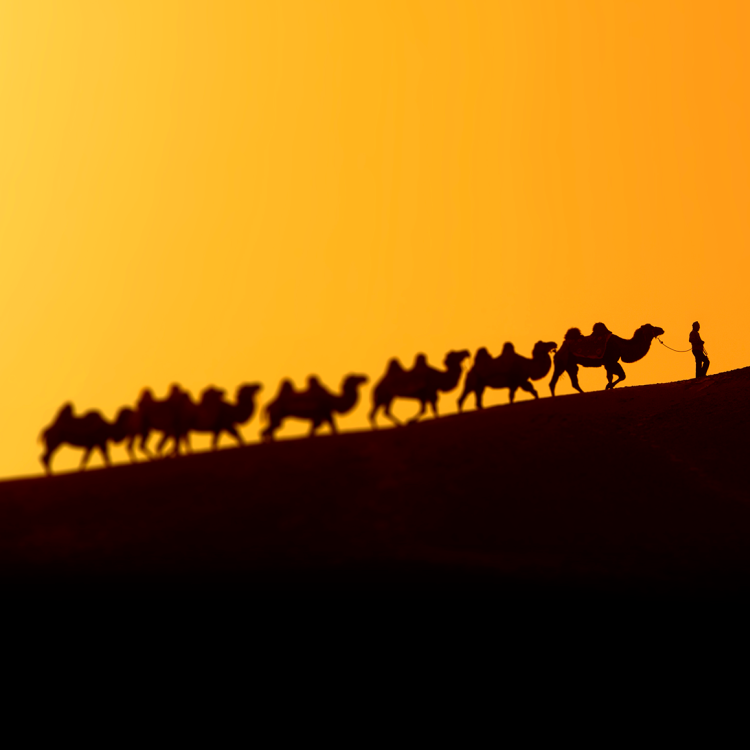See the exhibition
Silk Roads is open 26 September 2024 – 23 February 2025
About this guide
This guide is written using short, easy to read sentences.
It can be used by anyone, including visitors with additional learning needs, families and speakers of other languages.
This guide takes you on a tour of the exhibition.
It looks at 10 different objects.
A map of the exhibition shows you where to find the objects.
The exhibition has five sections. There is an introduction to each section.
Each object has a number. These numbers are on the exhibition map.
The map shows you where each object is in the exhibition.
Please let us know what you think about this guide. Tell a member of staff or email [email protected]
A large print guide containing the entire exhibition text is also available.
Introduction to Silk Roads
Have you heard of the Silk Road? What does it make you think of?
Some people imagine it as one long road linking the east and west parts of the world.
It was actually many routes going in different directions.
The Silk Roads had routes going east to west and north to south.
There were routes over land and sea.
Many other things more than silk travelled along these routes.
The Silk Roads allowed people, ideas and objects to move between different parts of the world.
Introduction to East Asia
Your journey begins at the eastern ends of the Silk Roads, in East Asia.
Japan, Korea and China are places in East Asia.
They had contact with each other.
They were also connected to the wider world.
People, goods and ideas travelled along the Silk Roads to China, Japan and Korea.
So did a religion called Buddhism.
1. Pottery camel
1. Pottery camel
Camels carried objects along the Silk Roads.
Camels can walk long distances without drinking.
This made them useful for crossing dry deserts.
This pottery camel has two humps.
It carries silk, fabric, a jug and possibly some meat.
2. Bronze figure
2. Bronze figure
The Buddhist religion spread from India to China.
Monks and traders travelling along the Silk Roads shared Buddhist teachings.
This figure is a Buddhist supernatural being.
It wears long flowing clothes.
It looks like figures from India, but it was found in China.
3. Dried food
3. Dried food
Travellers carried food and ingredients along the Silk Roads.
People could try new foods from far away.
New types of bread and cake became popular in China.
One of these bits of dough has been twisted to make a bow shape.
It survives because it dried out instead of rotting away.
4. Felt shoe
4. Felt shoe
Different fabrics were traded and used along the Silk Roads.
The fabrics included silk, felt and wool.
This shoe is made of thick felt.
Leather patches protected the felt from wearing away.
Fan-shaped stitches decorate the surface.
Introduction to Central Asia to Arabia
The Silk Roads helped to spread a religion called Islam.
Islam began in Arabia.
When Arab armies conquered new lands, they brought their religion with them.
They ruled over people with different religious beliefs.
Traders, scholars and artists travelled widely, helping to spread ideas.
Different ways of life mixed together.
5. Pottery dish with writing on
5. Pottery dish with writing on
People spoke many languages along the Silk Roads.
Arabic was the language of people from Arabia.
It spread as Arab people conquered new lands.
Some people began to use Arabic as well as their own language.
The writing around the edge of this dish is Arabic.
The text includes a saying about livelihood.
6. Glass blocks
6. Glass blocks
These glass blocks were used to make pictures or patterns called mosaics.
The mosaics probably decorated palaces or churches.
The glass was made by people who lived around the eastern Mediterranean Sea.
It was found a long way away, in Iraq.
Introduction to The Mediterranean
The Mediterranean Sea connected the east and west parts of the Silk Roads.
The Byzantine empire controlled the coasts and islands of the Mediterranean Sea.
The main language of the Byzantine empire was Greek, but people spoke many languages.
They followed the Christian religion.
They sometimes fought with other kingdoms.
7. Gold jewellery
7. Gold jewellery
Pearls and precious gemstones were traded long distances along the Silk Roads.
The gold necklace and earrings have sapphires and emeralds from India.
The pearls are from Arabia.
Only a very rich person could wear jewellery like this.
Perhaps it belonged to the Byzantine ruler or their family.
8. Pottery flask
8. Pottery flask
Christian pilgrims (people on a holy journey) travelled along the Silk Roads.
They visited special religious places.
They could bring back a pottery flask full of soil or holy water.
This flask was made in Egypt.
It was found in England.
Introduction to Northwest Europe
You've reached northwest Europe, at the western edge of the Silk Roads.
People here mostly exchanged objects with people nearby.
Things from faraway Africa and Asia also reached northwest Europe.
Silks and gems were popular.
Artists mixed foreign and local styles to make new things.
9. Gold shoulder clasp
9. Gold shoulder clasp
This clasp was worn over the shoulder, on top of thick clothing.
It was buried with an important person in England.
The bright red gems came from India, Sri Lanka and Central Europe.
It is decorated with twisting snakes.
Can you spot the two boars (wild pigs)?
10. Gold coin
10. Gold coin
This gold coin was made for Offa, a king in England.
Offa copied the coin of a powerful ruler of the Abbasid empire (in the present-day Middle East).
Abbasid coins used Arabic words.
There is Arabic and Latin (a European language) on Offa's coin.
Perhaps Offa copied it to link himself to Abbasid rulers.





